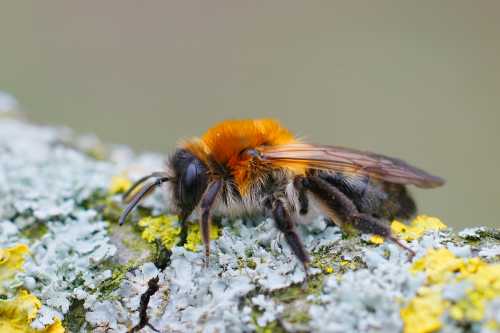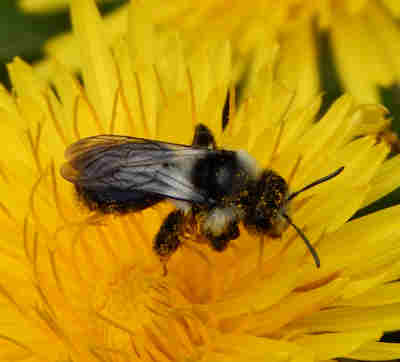Andrena nitida
- The Grey-patched mining bee
All kinds of bees love dandelions, and among the fans of this flower, we can include the Grey-patched mining bee, Andrena nitida.
In Britain, this species can be seen from late March
onwards through to July. I took these photographs of the female specimen below in early
April, which is peak season for this species through to May.
About Andrena nitida
 Grey-patched mining bee, Andrena nitida. Female
Grey-patched mining bee, Andrena nitida. FemaleFemales measure up to 12mm, males are a little smaller. They are slightly larger than a honey bee. This species is univoltine (having one generation, and therefore, one flight period in a year).
They are found in a variety of habitats. The photographs on this page were taken on a local old brownfield site close to where I live.
Nest sites
It likes to nest in flat or sloping turf, and according to Stephen Falk’s Bees of Great Britain and Ireland, nests may also occur in formal lawns as well as sheep-grazed hillsides.
Nest burrows are scattered rather than in aggregations.
 Grey-patched mining bee.
Grey-patched mining bee.Foraging preferences
In addition to dandelions, it may be seen foraging on
hawthorn, blackthorn, gorse, raspberry, dead nettles, speedwell, willow, and cherries.
If you want to catch sight of this bee species, check spring blossoms and flowering shrubs.
 Grey-patched mining bee, Andrena nitida.
Grey-patched mining bee, Andrena nitida.Parasites
 Gooden's Nomad Bee
Gooden's Nomad BeeIt may be attacked by the parasite, Gooden's Nomad Bee (Nomada goodeniana).
The Gooden's nomad bee enters the ground nest burrows of target hosts, such as the grey-patched mining bee, and lays an egg in a nest cell.
The emerging parasite destroys the grub of the host species, and eats the provided food stores.



